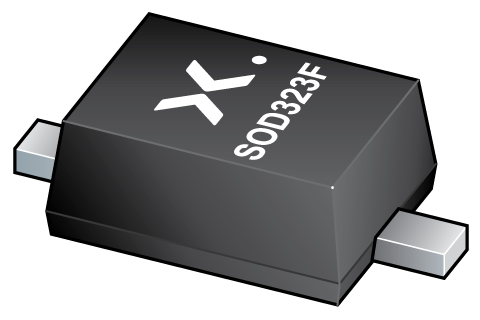Orderable parts
| Type number | Orderable part number | Ordering code (12NC) | Package | Buy from distributors |
|---|---|---|---|---|
| PZU11B2-Q | PZU11B2-QX | 934668322115 | SOD323F | Order product |

Register once, drag and drop ECAD models into your CAD tool and speed up your design.
Click here for more informationZener voltage regulator diodes in a SOD323F package
General-purpose Zener diodes in a SOD323F (SC-90) very small and flat lead Surface Mounted Device (SMD) plastic package.
Total power dissipation: 550 mW
Tolerance series: B: approximately 5 %; B2: approximately 2 %
Small plastic package suitable for surface mounted design
Wide working voltage range: nominal 2.4 V to 51 V
Very low leakage current for a given reverse voltage for types PZU5.1B-Q - PZU10B-Q
PZU5.1B2-Q - 10B-Q: Very low dynamic impedances at low currents, very low leakage current, hard breakdown knee
PZU11B2-Q - 51B-Q: Intentional minor rise of leakage current for optimized fast switching and noise reduction [Ref. AN90031]
Qualified according to AEC-Q101 and recommended for use in automotive applications
General regulation functions
| Type number | Package version | Package name | Size (mm) |
|---|---|---|---|
| PZU11B2‑Q | SOD323F | SC-90 | 1.7 x 1.25 x 0.7 |
| Type number | Orderable part number, (Ordering code (12NC)) | Status | Marking | Package | Package information | Reflow-/Wave soldering | Packing |
|---|---|---|---|---|---|---|---|
| PZU11B2‑Q | PZU11B2‑QX (934668322115) |
Active | HG |

SC‑90 (SOD323F) |
SOD323F |
WAVE_BG-BD-1
|
SOD323F_115 |
| Type number | Orderable part number | Chemical content | RoHS | RHF-indicator |
|---|---|---|---|---|
| PZU11B2‑Q | PZU11B2‑QX | PZU11B2-Q |
|
|
| File name | Title | Type | Date |
|---|---|---|---|
| PZUXB_B2-Q_SER | Zener voltage regulator diodes in a SOD323F package | Data sheet | 2025-07-23 |
| AN90063 | Questions about package outline drawings | Application note | 2025-10-22 |
| SOD323F | 3D model for products with SOD323F package | Design support | 2025-09-20 |
| SOT323F | 3D model for products with SOT323F package | Design support | 2019-01-22 |
| Nexperia_package_poster | Nexperia package poster | Leaflet | 2020-05-15 |
| SC-90_SOD323F_mk | plastic, surface-mounted package; 2 leads; 1.7 mm x 1.25 mm x 0.7 mm body | Marcom graphics | 2017-01-28 |
| REFLOW_BG-BD-1 | Reflow soldering profile | Other type | 2025-11-14 |
| SOD323F | plastic, surface-mounted package; 2 leads; 1.7 mm x 1.25 mm x 0.7 mm body | Package information | 2022-05-27 |
| SOD323F_115 | Reel pack for SMD, 7''; Q1/T1-Q2/T3 product orientation | Packing information | 2020-06-12 |
| WAVE_BG-BD-1 | Wave soldering profile | Wave soldering | 2021-09-08 |
If you are in need of design/technical support, let us know and fill in the answer form we'll get back to you shortly.
The Nexperia Longevity Program is aimed to provide our customers information from time to time about the expected time that our products can be ordered. The NLP is reviewed and updated regularly by our Executive Management Team. View our longevity program here.
| Type number | Orderable part number | Ordering code (12NC) | Status | Packing | Packing Quantity | Buy online |
|---|---|---|---|---|---|---|
| PZU11B2‑Q | PZU11B2‑QX | 934668322115 | Active | SOD323F_115 | 3,000 |
|
As a Nexperia customer you can order samples via our sales organization.
If you do not have a direct account with Nexperia our network of global and regional distributors is available and equipped to support you with Nexperia samples. Check out the list of official distributors.
The interactive datasheets are based on the Nexperia MOSFET precision electrothermal models. With our interactive datasheets you can simply specify your own conditions interactively. Start by changing the values of the conditions. You can do this by using the sliders in the condition fields. By dragging the sliders you will see how the MOSFET will perform at the new conditions set.